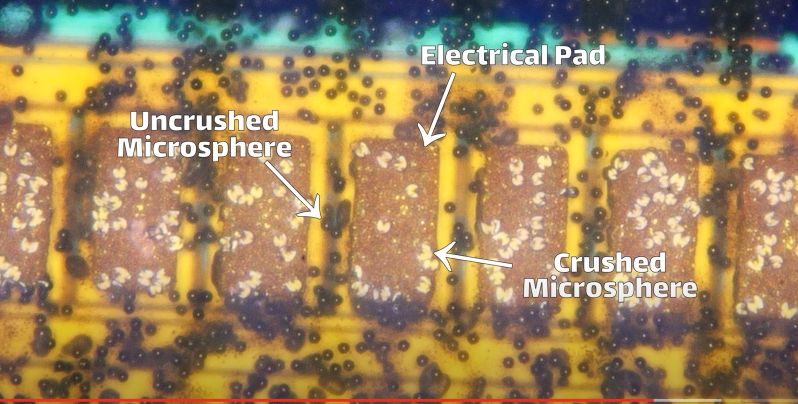Liquid crystal and Organic LED displays have revolutionized portable computing. They’re also made of glass. Which presents a problem: How do we get electrical signals from fiberglass circuit boards to the glass displays? The answer is double-sided adhesive tape. But we’re not talking about packing tape here. As [Breakingtaps] explains, this tape has a trick up its sleeve.
The magic is that the tape conducts only in the vertical plane. Even more so, any two conducting sections of the tape are insulated from each other. How does it do that? Magic beans balls, of course!
The tape and adhesive are insulators. Embedded in the adhesive are tiny spheres. The spheres are made of plastic and coated with metal. When the tape (also known as ACF or Anisotropic Conductive Film) is pressed between a PCB with conductors and glass, a few spheres are squished down between the layers. Electrical signals pass between the squished spheres, allowing an image to be displayed on the glass screen. The final step uses heat and pressure to bond the adhesive and cure it. You can also get the material in paste form if you don’t like the tape.
The system works so well that it can be used for connections from a silicon chip directly to the glass. This is how many display controllers are mounted right to the module — definitely an improvement on the rubber strips used on LCDs of the past.

















Pretty ingenious solution. I bet whoever came up with that was pleased.
It’s readily available and not all that expensive. For example: https://www.adafruit.com/product/1656
I’m wondering what’s the current density in these microsphere connexions?
Also one might use the tape to make multilayer pcbs from several two layer pcbs, flexible or none flexible.
Or one could sandwich together a bunch of the tapes arranged at right angles to each other and then use a laser to fuse just those channels you want to hook together and voilá – poor man’s FPGA.
So this is where the hot pressing along the edge may or may not fix bad lines in a display? It is definitely why the edge connections of a display are so fragile.